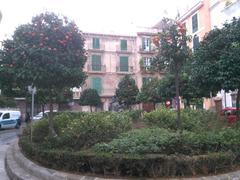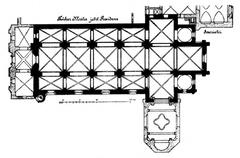Comprehensive Guide to Visiting Historic Mine Ignatius, Rybnik, Poland
Date: 20/07/2024
Introduction
The Historic Mine Ignatius, situated in Rybnik, Poland, is a monument of immense historical and industrial significance. Established in 1792, the mine has been a cornerstone of the region’s economic and social development for over two centuries. Named after Saint Ignatius of Loyola, the mine reflects the deep-rooted Catholic traditions of the area. During its operational years, the mine contributed significantly to the local economy and was at the forefront of technological innovations in the coal mining industry, making it one of the most advanced mining operations of its time (source). The mine’s history is intertwined with key events such as the Industrial Revolution, both World Wars, and the post-war industrial boom, each leaving its mark on the site’s evolution. Today, the Historic Mine Ignatius stands preserved as a museum and cultural site, offering guided tours that provide insights into the daily lives of miners, the technological advancements made over the years, and the mine’s considerable social and economic impact on the region (source). It serves as a testament to the resilience and ingenuity of the local community, making it a must-visit destination for those interested in industrial history and heritage.
Table of Contents
- [Early Beginnings](#early-beginningsearly-beginnings)
- [Industrial Revolution and Expansion](#industrial-revolution-and-expansionindustrial-revolution-and-expansion)
- [World War I and Interwar Period](#world-war-i-and-interwar-periodworld-war-i-and-interwar-period)
- [World War II and Post-War Era](#world-war-ii-and-post-war-eraworld-war-ii-and-post-war-era)
- [Decline and Closure](#decline-and-closuredecline-and-closure)
- [Preservation and Cultural Significance](#preservation-and-cultural-significancepreservation-and-cultural-significance)
- [Technological Innovations](#technological-innovationstechnological-innovations)
- [Social and Economic Impact](#social-and-economic-impactsocial-and-economic-impact)
- [Environmental Considerations](#environmental-considerationsenvironmental-considerations)
- [Visitor Experience](#visitor-experiencevisitor-experience)
- [Nearby Attractions and Travel Tips](#nearby-attractions-and-travel-tipsnearby-attractions-and-travel-tips)
- [FAQ](#faqfaq)
- [Conclusion](#conclusionconclusion)
Discover the Historic Mine Ignatius - Visiting Hours, Tickets, and Rich History in Rybnik
Early Beginnings
The Historic Mine Ignatius, located in Rybnik, Poland, has a rich history that dates back to the early 19th century. Officially established in 1792, during a period of significant industrial growth in Europe, the mine was named after Saint Ignatius of Loyola, reflecting the religious influences of the time. The region of Silesia, where Rybnik is situated, was known for its abundant coal reserves, which attracted numerous mining ventures.
Industrial Revolution and Expansion
The 19th century marked a period of rapid industrialization in Europe, and the Ignatius Mine was no exception. By the mid-1800s, the mine had expanded significantly, employing hundreds of workers and contributing to the local economy. The introduction of steam engines and other technological advancements allowed for deeper and more efficient extraction of coal. This period also saw the construction of extensive underground tunnels and the establishment of surface facilities, including processing plants and worker accommodations.
World War I and Interwar Period
The outbreak of World War I in 1914 had a profound impact on the Ignatius Mine. The demand for coal surged as it was a critical resource for the war effort. The mine operated at full capacity, and many workers were conscripted into the military, leading to labor shortages. Despite these challenges, the mine continued to produce significant quantities of coal.
The interwar period brought about modernization efforts. In the 1920s and 1930s, the mine underwent several upgrades, including the installation of electric pumps and improved ventilation systems. These advancements not only increased production but also enhanced the safety and working conditions for miners.
World War II and Post-War Era
During World War II, the Ignatius Mine fell under German control as Poland was occupied by Nazi forces. The mine’s output was directed towards supporting the German war machine. This period was marked by harsh working conditions and forced labor, as many local residents and prisoners of war were compelled to work in the mines.
After the war, the mine was nationalized and became part of the state-owned coal industry in Poland. The post-war era saw significant investments in infrastructure and technology. The 1950s and 1960s were particularly notable for the introduction of mechanized mining equipment, which further boosted production and efficiency.
Decline and Closure
The latter half of the 20th century saw a decline in the coal industry in Europe, and the Ignatius Mine was no exception. By the 1980s, the mine faced numerous challenges, including depleted coal seams, increased production costs, and environmental concerns. Despite efforts to modernize and improve efficiency, the mine struggled to remain profitable.
In 1995, after more than two centuries of operation, the Ignatius Mine was officially closed. The closure marked the end of an era for the local community, many of whom had generations of family members who worked in the mine. The site was subsequently preserved as a historical monument, recognizing its significant contribution to the region’s industrial heritage.
Preservation and Cultural Significance
Today, the Historic Mine Ignatius serves as a museum and cultural site, attracting visitors from around the world. The preservation efforts have focused on maintaining the original structures and equipment, providing a glimpse into the life and work of miners over the centuries. The site includes guided tours of the underground tunnels, exhibitions on mining technology, and displays of historical artifacts.
The mine is also a venue for various cultural events and educational programs. These initiatives aim to educate the public about the history of mining in the region and its impact on the local community. The site has been recognized as a significant cultural heritage site by the Polish government and various international organizations.
Technological Innovations
Throughout its operational history, the Ignatius Mine was at the forefront of technological innovations in the mining industry. The introduction of steam engines in the 19th century revolutionized coal extraction, allowing for deeper mining operations. The early 20th century saw the adoption of electric pumps and mechanized equipment, which significantly increased productivity and safety.
One of the notable technological advancements was the implementation of the longwall mining method in the mid-20th century. This method involved the use of a mechanized shearer to cut coal along a long face, which was then transported via conveyor belts. This technique not only improved efficiency but also reduced the physical strain on miners.
Social and Economic Impact
The Ignatius Mine played a crucial role in the social and economic development of Rybnik and the surrounding region. The mine provided employment for thousands of workers over its operational history, contributing to the growth of the local economy. The influx of workers led to the development of housing, schools, and other infrastructure, transforming Rybnik into a bustling industrial town.
The mine also had a significant impact on the social fabric of the community. Mining was often a family tradition, with multiple generations working in the mine. This created a strong sense of camaraderie and solidarity among the workers. The mine’s closure in 1995 had a profound effect on the community, leading to economic challenges and a period of adjustment as the region transitioned away from its industrial roots.
Environmental Considerations
The environmental impact of the Ignatius Mine was a significant concern, particularly in its later years of operation. The extraction of coal and the associated activities led to land subsidence, water pollution, and air quality issues. Efforts were made to mitigate these impacts through various environmental protection measures, including land reclamation and water treatment initiatives.
Since its closure, the site has undergone extensive environmental rehabilitation. The preservation of the mine as a historical site includes efforts to restore the surrounding landscape and address any lingering environmental issues. These efforts aim to balance the preservation of industrial heritage with the need for environmental sustainability.
Visitor Experience
Visitors to the Historic Mine Ignatius can explore a range of attractions that provide an immersive experience of the site’s history and significance. Guided tours take visitors through the underground tunnels, showcasing the mining techniques and equipment used over the centuries. The tours also highlight the working conditions and daily life of miners, providing a poignant reminder of the challenges they faced.
The museum features exhibitions on the history of mining in the region, including displays of historical artifacts, photographs, and documents. Interactive exhibits and multimedia presentations offer a deeper understanding of the technological advancements and social impact of the mine.
For more information on visiting the Historic Mine Ignatius, including tour schedules, ticket prices, and special packages, please visit the official website.
Nearby Attractions and Travel Tips
When visiting the Historic Mine Ignatius, consider exploring other historical sites in Rybnik, such as the Rybnik Castle and the Basilica of St. Anthony of Padua. The town offers a variety of dining and accommodation options to suit different preferences and budgets.
Accessibility Information: The Historic Mine Ignatius is committed to providing access to all visitors. Most areas of the site, including the museum and exhibitions, are wheelchair accessible. However, certain underground sections may have limited accessibility. Please check the official website for detailed accessibility information.
FAQ
What are the visiting hours for Historic Mine Ignatius?
The visiting hours for Historic Mine Ignatius vary by season. Please visit the official website for the most up-to-date information.
How much are the tickets for the Historic Mine Ignatius tour?
Ticket prices for the Historic Mine Ignatius tour vary depending on the type of tour and any special packages. Visit the official website for detailed pricing information.
Is Historic Mine Ignatius accessible for people with disabilities?
The Historic Mine Ignatius site is committed to accessibility. While most areas are wheelchair accessible, certain underground sections may have limited access. For detailed accessibility information, please refer to the official website.
Conclusion
The Historic Mine Ignatius stands as a testament to the rich industrial heritage of Rybnik and the broader Silesian region. Its history reflects the broader trends of industrialization, technological innovation, and social change that have shaped the modern world. Today, the site serves as a valuable cultural and educational resource, preserving the legacy of the miners and their contributions to the region’s development. Visit the official website for more information, related posts, and updates on upcoming events.
References
- Discover the Historic Mine Ignatius - Visiting Hours, Tickets, and Rich History in Rybnik, 2024, Historic Mine Ignatius
- Visiting Historic Mine Ignatius in Rybnik - Hours, Tickets, and Travel Tips, 2024, Rybnik Official
- Visitor Tips for Historic Mine Ignatius in Rybnik - Hours, Tickets, and Travel Tips, 2024, Muzeum Rybnik

